Financial Analysis Report for For-U Jeans Project: Customization Lab
VerifiedAdded on 2020/03/16
|24
|5501
|257
Report
AI Summary
This report presents a comprehensive financial analysis of the proposed Customization Lab project for For-U Jeans. It evaluates the investment's financial viability by examining costs, revenue projections, and potential risks. The report includes a detailed breakdown of costs of goods sold, profit margins, and key financial metrics like Annual Rate of Return (ARR), Net Present Value (NPV), and Internal Rate of Return (IRR). Additionally, it incorporates a preliminary risk analysis, addressing supply chain, financial, marketing, and operational risks. Sensitivity analysis explores various scenarios, and recommendations are provided for financial sustainability. The report also considers the introduction of a complementary "Freedom Jeans" line and provides a decision analysis to guide management's investment decisions.
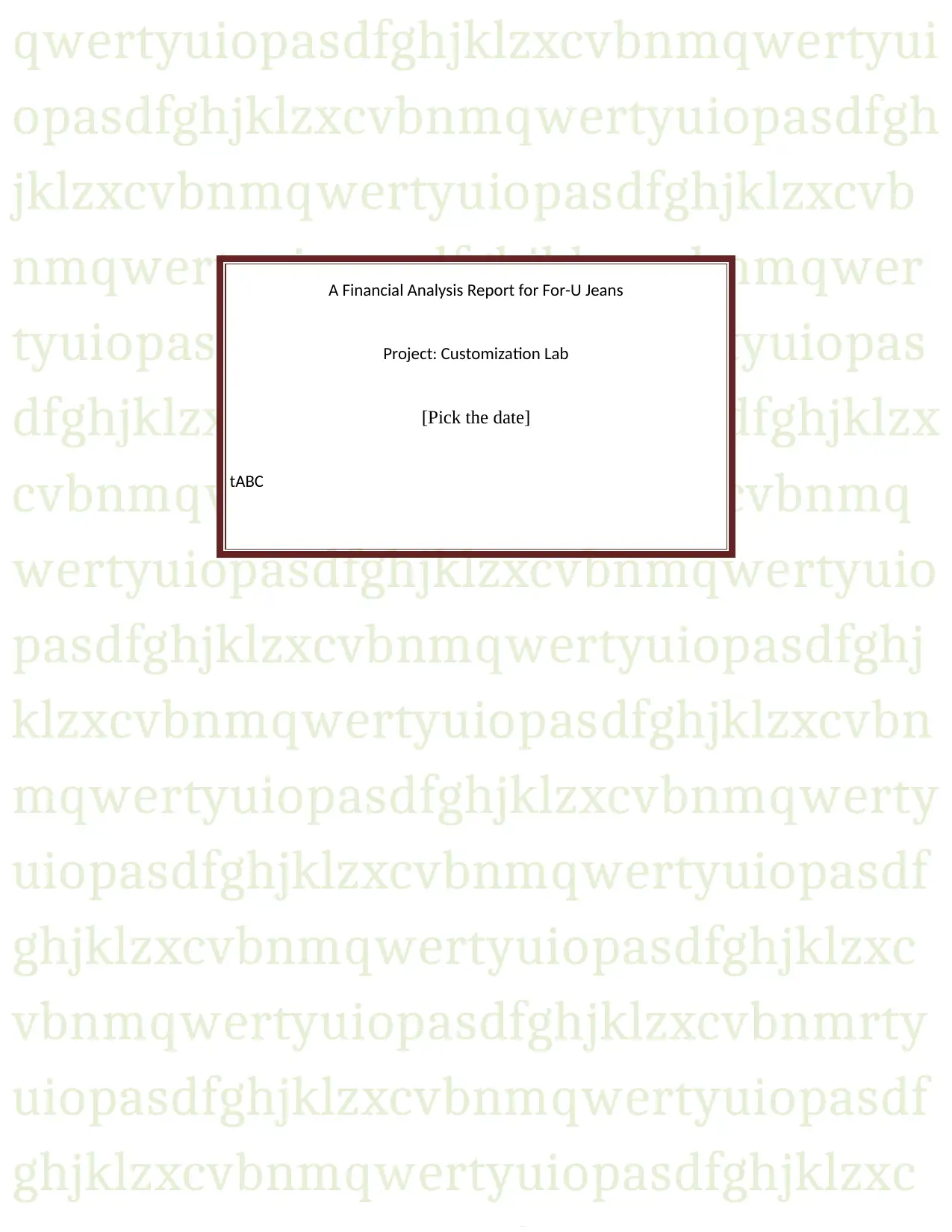
qwertyuiopasdfghjklzxcvbnmqwertyui
opasdfghjklzxcvbnmqwertyuiopasdfgh
jklzxcvbnmqwertyuiopasdfghjklzxcvb
nmqwertyuiopasdfghjklzxcvbnmqwer
tyuiopasdfghjklzxcvbnmqwertyuiopas
dfghjklzxcvbnmqwertyuiopasdfghjklzx
cvbnmqwertyuiopasdfghjklzxcvbnmq
wertyuiopasdfghjklzxcvbnmqwertyuio
pasdfghjklzxcvbnmqwertyuiopasdfghj
klzxcvbnmqwertyuiopasdfghjklzxcvbn
mqwertyuiopasdfghjklzxcvbnmqwerty
uiopasdfghjklzxcvbnmqwertyuiopasdf
ghjklzxcvbnmqwertyuiopasdfghjklzxc
vbnmqwertyuiopasdfghjklzxcvbnmrty
uiopasdfghjklzxcvbnmqwertyuiopasdf
ghjklzxcvbnmqwertyuiopasdfghjklzxc
A Financial Analysis Report for For-U Jeans
Project: Customization Lab
[Pick the date]
tABC
opasdfghjklzxcvbnmqwertyuiopasdfgh
jklzxcvbnmqwertyuiopasdfghjklzxcvb
nmqwertyuiopasdfghjklzxcvbnmqwer
tyuiopasdfghjklzxcvbnmqwertyuiopas
dfghjklzxcvbnmqwertyuiopasdfghjklzx
cvbnmqwertyuiopasdfghjklzxcvbnmq
wertyuiopasdfghjklzxcvbnmqwertyuio
pasdfghjklzxcvbnmqwertyuiopasdfghj
klzxcvbnmqwertyuiopasdfghjklzxcvbn
mqwertyuiopasdfghjklzxcvbnmqwerty
uiopasdfghjklzxcvbnmqwertyuiopasdf
ghjklzxcvbnmqwertyuiopasdfghjklzxc
vbnmqwertyuiopasdfghjklzxcvbnmrty
uiopasdfghjklzxcvbnmqwertyuiopasdf
ghjklzxcvbnmqwertyuiopasdfghjklzxc
A Financial Analysis Report for For-U Jeans
Project: Customization Lab
[Pick the date]
tABC
Paraphrase This Document
Need a fresh take? Get an instant paraphrase of this document with our AI Paraphraser
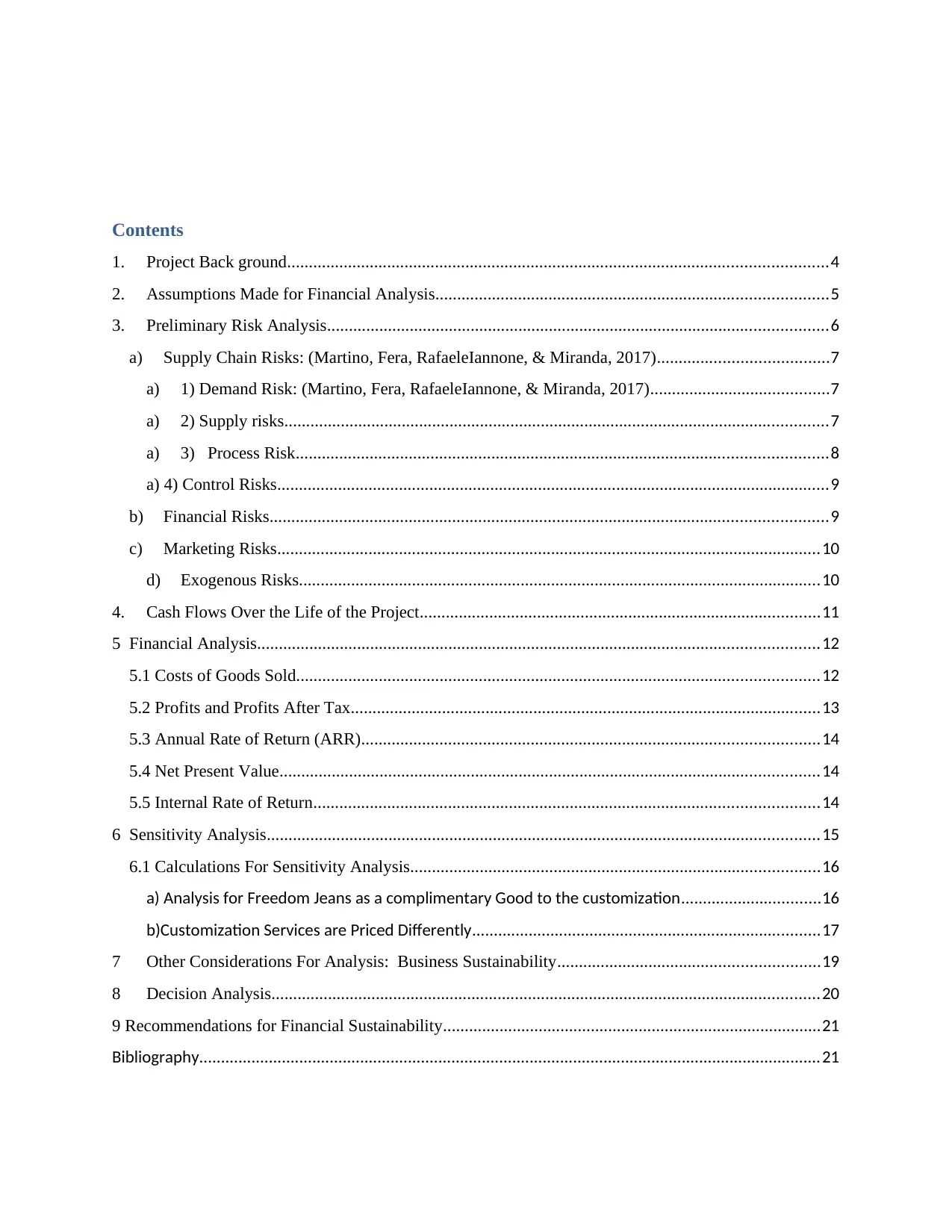
Contents
1. Project Back ground............................................................................................................................4
2. Assumptions Made for Financial Analysis..........................................................................................5
3. Preliminary Risk Analysis...................................................................................................................6
a) Supply Chain Risks: (Martino, Fera, RafaeleIannone, & Miranda, 2017).......................................7
a) 1) Demand Risk: (Martino, Fera, RafaeleIannone, & Miranda, 2017).........................................7
a) 2) Supply risks.............................................................................................................................7
a) 3) Process Risk..........................................................................................................................8
a) 4) Control Risks...............................................................................................................................9
b) Financial Risks................................................................................................................................9
c) Marketing Risks.............................................................................................................................10
d) Exogenous Risks........................................................................................................................10
4. Cash Flows Over the Life of the Project............................................................................................11
5 Financial Analysis.................................................................................................................................12
5.1 Costs of Goods Sold........................................................................................................................12
5.2 Profits and Profits After Tax............................................................................................................13
5.3 Annual Rate of Return (ARR).........................................................................................................14
5.4 Net Present Value............................................................................................................................14
5.5 Internal Rate of Return....................................................................................................................14
6 Sensitivity Analysis...............................................................................................................................15
6.1 Calculations For Sensitivity Analysis..............................................................................................16
a) Analysis for Freedom Jeans as a complimentary Good to the customization................................16
b)Customization Services are Priced Differently................................................................................17
7 Other Considerations For Analysis: Business Sustainability............................................................19
8 Decision Analysis..............................................................................................................................20
9 Recommendations for Financial Sustainability.......................................................................................21
Bibliography...............................................................................................................................................21
1. Project Back ground............................................................................................................................4
2. Assumptions Made for Financial Analysis..........................................................................................5
3. Preliminary Risk Analysis...................................................................................................................6
a) Supply Chain Risks: (Martino, Fera, RafaeleIannone, & Miranda, 2017).......................................7
a) 1) Demand Risk: (Martino, Fera, RafaeleIannone, & Miranda, 2017).........................................7
a) 2) Supply risks.............................................................................................................................7
a) 3) Process Risk..........................................................................................................................8
a) 4) Control Risks...............................................................................................................................9
b) Financial Risks................................................................................................................................9
c) Marketing Risks.............................................................................................................................10
d) Exogenous Risks........................................................................................................................10
4. Cash Flows Over the Life of the Project............................................................................................11
5 Financial Analysis.................................................................................................................................12
5.1 Costs of Goods Sold........................................................................................................................12
5.2 Profits and Profits After Tax............................................................................................................13
5.3 Annual Rate of Return (ARR).........................................................................................................14
5.4 Net Present Value............................................................................................................................14
5.5 Internal Rate of Return....................................................................................................................14
6 Sensitivity Analysis...............................................................................................................................15
6.1 Calculations For Sensitivity Analysis..............................................................................................16
a) Analysis for Freedom Jeans as a complimentary Good to the customization................................16
b)Customization Services are Priced Differently................................................................................17
7 Other Considerations For Analysis: Business Sustainability............................................................19
8 Decision Analysis..............................................................................................................................20
9 Recommendations for Financial Sustainability.......................................................................................21
Bibliography...............................................................................................................................................21

⊘ This is a preview!⊘
Do you want full access?
Subscribe today to unlock all pages.

Trusted by 1+ million students worldwide
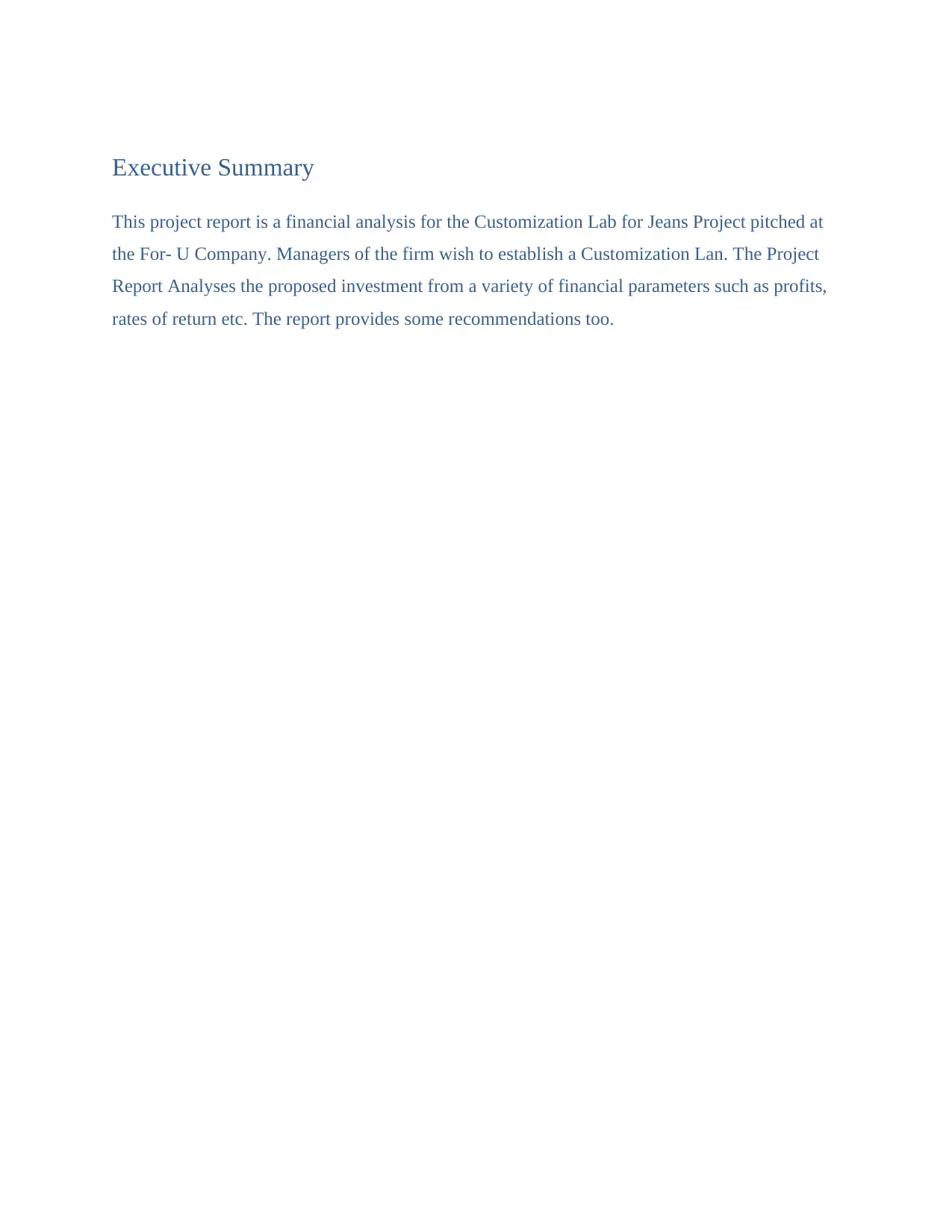
Executive Summary
This project report is a financial analysis for the Customization Lab for Jeans Project pitched at
the For- U Company. Managers of the firm wish to establish a Customization Lan. The Project
Report Analyses the proposed investment from a variety of financial parameters such as profits,
rates of return etc. The report provides some recommendations too.
This project report is a financial analysis for the Customization Lab for Jeans Project pitched at
the For- U Company. Managers of the firm wish to establish a Customization Lan. The Project
Report Analyses the proposed investment from a variety of financial parameters such as profits,
rates of return etc. The report provides some recommendations too.
Paraphrase This Document
Need a fresh take? Get an instant paraphrase of this document with our AI Paraphraser
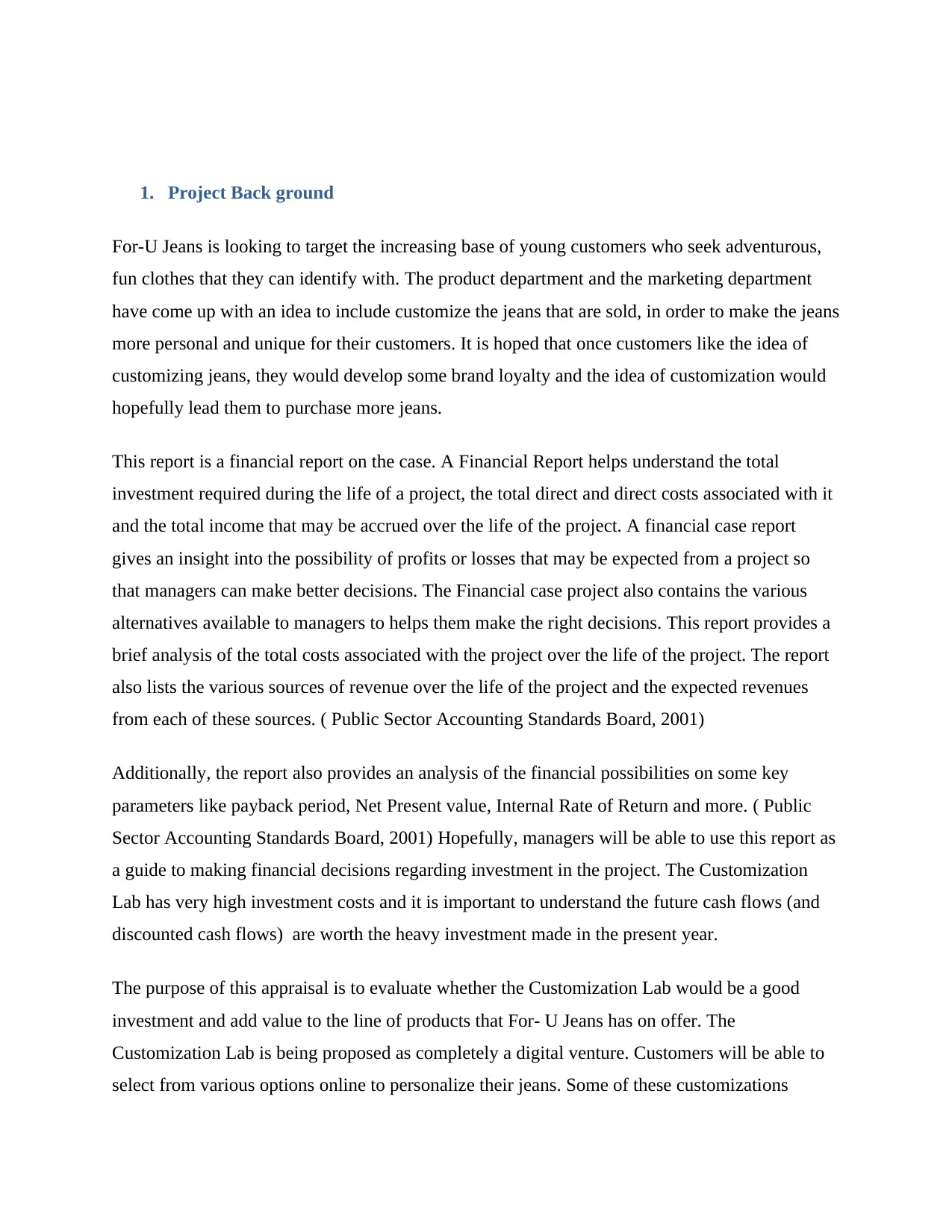
1. Project Back ground
For-U Jeans is looking to target the increasing base of young customers who seek adventurous,
fun clothes that they can identify with. The product department and the marketing department
have come up with an idea to include customize the jeans that are sold, in order to make the jeans
more personal and unique for their customers. It is hoped that once customers like the idea of
customizing jeans, they would develop some brand loyalty and the idea of customization would
hopefully lead them to purchase more jeans.
This report is a financial report on the case. A Financial Report helps understand the total
investment required during the life of a project, the total direct and direct costs associated with it
and the total income that may be accrued over the life of the project. A financial case report
gives an insight into the possibility of profits or losses that may be expected from a project so
that managers can make better decisions. The Financial case project also contains the various
alternatives available to managers to helps them make the right decisions. This report provides a
brief analysis of the total costs associated with the project over the life of the project. The report
also lists the various sources of revenue over the life of the project and the expected revenues
from each of these sources. ( Public Sector Accounting Standards Board, 2001)
Additionally, the report also provides an analysis of the financial possibilities on some key
parameters like payback period, Net Present value, Internal Rate of Return and more. ( Public
Sector Accounting Standards Board, 2001) Hopefully, managers will be able to use this report as
a guide to making financial decisions regarding investment in the project. The Customization
Lab has very high investment costs and it is important to understand the future cash flows (and
discounted cash flows) are worth the heavy investment made in the present year.
The purpose of this appraisal is to evaluate whether the Customization Lab would be a good
investment and add value to the line of products that For- U Jeans has on offer. The
Customization Lab is being proposed as completely a digital venture. Customers will be able to
select from various options online to personalize their jeans. Some of these customizations
For-U Jeans is looking to target the increasing base of young customers who seek adventurous,
fun clothes that they can identify with. The product department and the marketing department
have come up with an idea to include customize the jeans that are sold, in order to make the jeans
more personal and unique for their customers. It is hoped that once customers like the idea of
customizing jeans, they would develop some brand loyalty and the idea of customization would
hopefully lead them to purchase more jeans.
This report is a financial report on the case. A Financial Report helps understand the total
investment required during the life of a project, the total direct and direct costs associated with it
and the total income that may be accrued over the life of the project. A financial case report
gives an insight into the possibility of profits or losses that may be expected from a project so
that managers can make better decisions. The Financial case project also contains the various
alternatives available to managers to helps them make the right decisions. This report provides a
brief analysis of the total costs associated with the project over the life of the project. The report
also lists the various sources of revenue over the life of the project and the expected revenues
from each of these sources. ( Public Sector Accounting Standards Board, 2001)
Additionally, the report also provides an analysis of the financial possibilities on some key
parameters like payback period, Net Present value, Internal Rate of Return and more. ( Public
Sector Accounting Standards Board, 2001) Hopefully, managers will be able to use this report as
a guide to making financial decisions regarding investment in the project. The Customization
Lab has very high investment costs and it is important to understand the future cash flows (and
discounted cash flows) are worth the heavy investment made in the present year.
The purpose of this appraisal is to evaluate whether the Customization Lab would be a good
investment and add value to the line of products that For- U Jeans has on offer. The
Customization Lab is being proposed as completely a digital venture. Customers will be able to
select from various options online to personalize their jeans. Some of these customizations
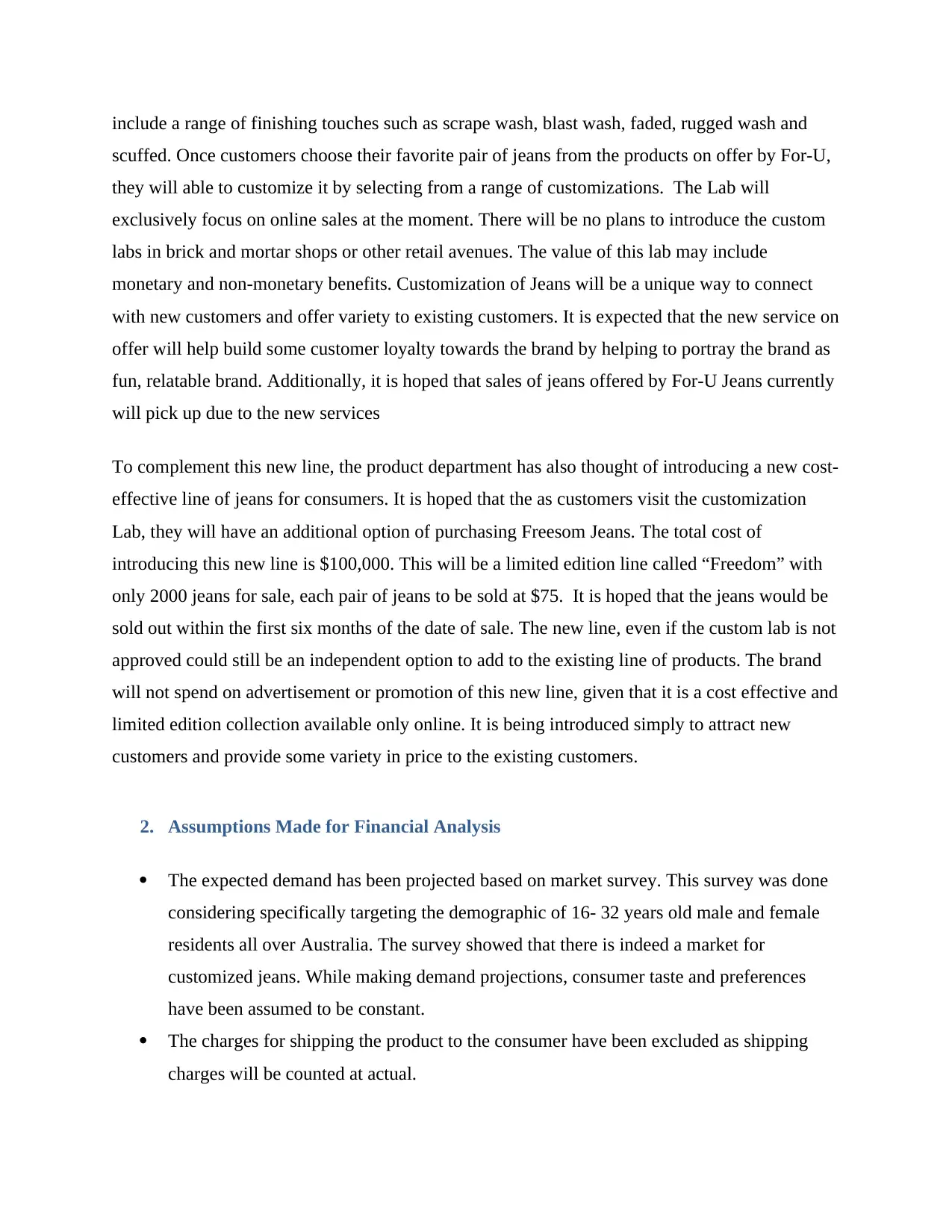
include a range of finishing touches such as scrape wash, blast wash, faded, rugged wash and
scuffed. Once customers choose their favorite pair of jeans from the products on offer by For-U,
they will able to customize it by selecting from a range of customizations. The Lab will
exclusively focus on online sales at the moment. There will be no plans to introduce the custom
labs in brick and mortar shops or other retail avenues. The value of this lab may include
monetary and non-monetary benefits. Customization of Jeans will be a unique way to connect
with new customers and offer variety to existing customers. It is expected that the new service on
offer will help build some customer loyalty towards the brand by helping to portray the brand as
fun, relatable brand. Additionally, it is hoped that sales of jeans offered by For-U Jeans currently
will pick up due to the new services
To complement this new line, the product department has also thought of introducing a new cost-
effective line of jeans for consumers. It is hoped that the as customers visit the customization
Lab, they will have an additional option of purchasing Freesom Jeans. The total cost of
introducing this new line is $100,000. This will be a limited edition line called “Freedom” with
only 2000 jeans for sale, each pair of jeans to be sold at $75. It is hoped that the jeans would be
sold out within the first six months of the date of sale. The new line, even if the custom lab is not
approved could still be an independent option to add to the existing line of products. The brand
will not spend on advertisement or promotion of this new line, given that it is a cost effective and
limited edition collection available only online. It is being introduced simply to attract new
customers and provide some variety in price to the existing customers.
2. Assumptions Made for Financial Analysis
The expected demand has been projected based on market survey. This survey was done
considering specifically targeting the demographic of 16- 32 years old male and female
residents all over Australia. The survey showed that there is indeed a market for
customized jeans. While making demand projections, consumer taste and preferences
have been assumed to be constant.
The charges for shipping the product to the consumer have been excluded as shipping
charges will be counted at actual.
scuffed. Once customers choose their favorite pair of jeans from the products on offer by For-U,
they will able to customize it by selecting from a range of customizations. The Lab will
exclusively focus on online sales at the moment. There will be no plans to introduce the custom
labs in brick and mortar shops or other retail avenues. The value of this lab may include
monetary and non-monetary benefits. Customization of Jeans will be a unique way to connect
with new customers and offer variety to existing customers. It is expected that the new service on
offer will help build some customer loyalty towards the brand by helping to portray the brand as
fun, relatable brand. Additionally, it is hoped that sales of jeans offered by For-U Jeans currently
will pick up due to the new services
To complement this new line, the product department has also thought of introducing a new cost-
effective line of jeans for consumers. It is hoped that the as customers visit the customization
Lab, they will have an additional option of purchasing Freesom Jeans. The total cost of
introducing this new line is $100,000. This will be a limited edition line called “Freedom” with
only 2000 jeans for sale, each pair of jeans to be sold at $75. It is hoped that the jeans would be
sold out within the first six months of the date of sale. The new line, even if the custom lab is not
approved could still be an independent option to add to the existing line of products. The brand
will not spend on advertisement or promotion of this new line, given that it is a cost effective and
limited edition collection available only online. It is being introduced simply to attract new
customers and provide some variety in price to the existing customers.
2. Assumptions Made for Financial Analysis
The expected demand has been projected based on market survey. This survey was done
considering specifically targeting the demographic of 16- 32 years old male and female
residents all over Australia. The survey showed that there is indeed a market for
customized jeans. While making demand projections, consumer taste and preferences
have been assumed to be constant.
The charges for shipping the product to the consumer have been excluded as shipping
charges will be counted at actual.
⊘ This is a preview!⊘
Do you want full access?
Subscribe today to unlock all pages.

Trusted by 1+ million students worldwide
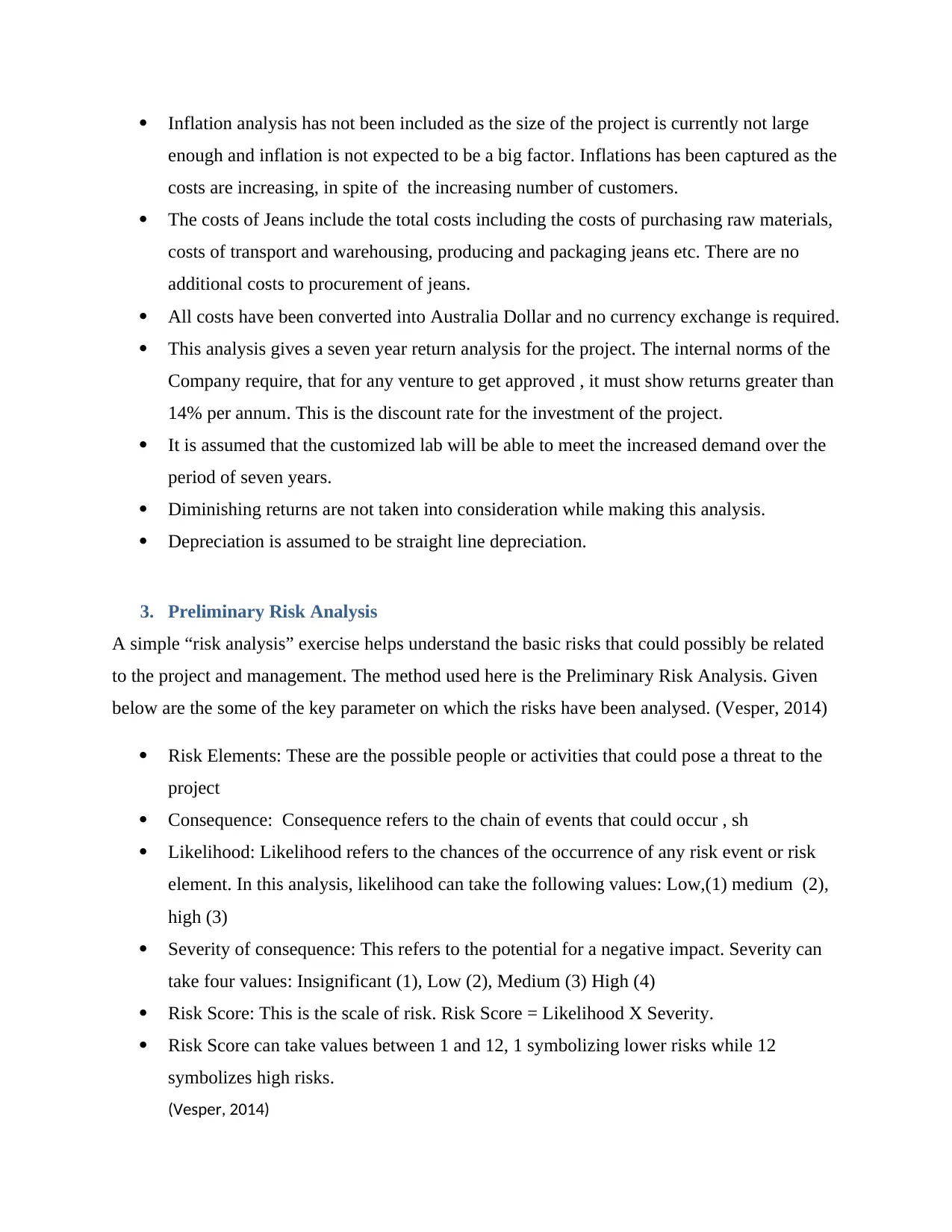
Inflation analysis has not been included as the size of the project is currently not large
enough and inflation is not expected to be a big factor. Inflations has been captured as the
costs are increasing, in spite of the increasing number of customers.
The costs of Jeans include the total costs including the costs of purchasing raw materials,
costs of transport and warehousing, producing and packaging jeans etc. There are no
additional costs to procurement of jeans.
All costs have been converted into Australia Dollar and no currency exchange is required.
This analysis gives a seven year return analysis for the project. The internal norms of the
Company require, that for any venture to get approved , it must show returns greater than
14% per annum. This is the discount rate for the investment of the project.
It is assumed that the customized lab will be able to meet the increased demand over the
period of seven years.
Diminishing returns are not taken into consideration while making this analysis.
Depreciation is assumed to be straight line depreciation.
3. Preliminary Risk Analysis
A simple “risk analysis” exercise helps understand the basic risks that could possibly be related
to the project and management. The method used here is the Preliminary Risk Analysis. Given
below are the some of the key parameter on which the risks have been analysed. (Vesper, 2014)
Risk Elements: These are the possible people or activities that could pose a threat to the
project
Consequence: Consequence refers to the chain of events that could occur , sh
Likelihood: Likelihood refers to the chances of the occurrence of any risk event or risk
element. In this analysis, likelihood can take the following values: Low,(1) medium (2),
high (3)
Severity of consequence: This refers to the potential for a negative impact. Severity can
take four values: Insignificant (1), Low (2), Medium (3) High (4)
Risk Score: This is the scale of risk. Risk Score = Likelihood X Severity.
Risk Score can take values between 1 and 12, 1 symbolizing lower risks while 12
symbolizes high risks.
(Vesper, 2014)
enough and inflation is not expected to be a big factor. Inflations has been captured as the
costs are increasing, in spite of the increasing number of customers.
The costs of Jeans include the total costs including the costs of purchasing raw materials,
costs of transport and warehousing, producing and packaging jeans etc. There are no
additional costs to procurement of jeans.
All costs have been converted into Australia Dollar and no currency exchange is required.
This analysis gives a seven year return analysis for the project. The internal norms of the
Company require, that for any venture to get approved , it must show returns greater than
14% per annum. This is the discount rate for the investment of the project.
It is assumed that the customized lab will be able to meet the increased demand over the
period of seven years.
Diminishing returns are not taken into consideration while making this analysis.
Depreciation is assumed to be straight line depreciation.
3. Preliminary Risk Analysis
A simple “risk analysis” exercise helps understand the basic risks that could possibly be related
to the project and management. The method used here is the Preliminary Risk Analysis. Given
below are the some of the key parameter on which the risks have been analysed. (Vesper, 2014)
Risk Elements: These are the possible people or activities that could pose a threat to the
project
Consequence: Consequence refers to the chain of events that could occur , sh
Likelihood: Likelihood refers to the chances of the occurrence of any risk event or risk
element. In this analysis, likelihood can take the following values: Low,(1) medium (2),
high (3)
Severity of consequence: This refers to the potential for a negative impact. Severity can
take four values: Insignificant (1), Low (2), Medium (3) High (4)
Risk Score: This is the scale of risk. Risk Score = Likelihood X Severity.
Risk Score can take values between 1 and 12, 1 symbolizing lower risks while 12
symbolizes high risks.
(Vesper, 2014)
Paraphrase This Document
Need a fresh take? Get an instant paraphrase of this document with our AI Paraphraser
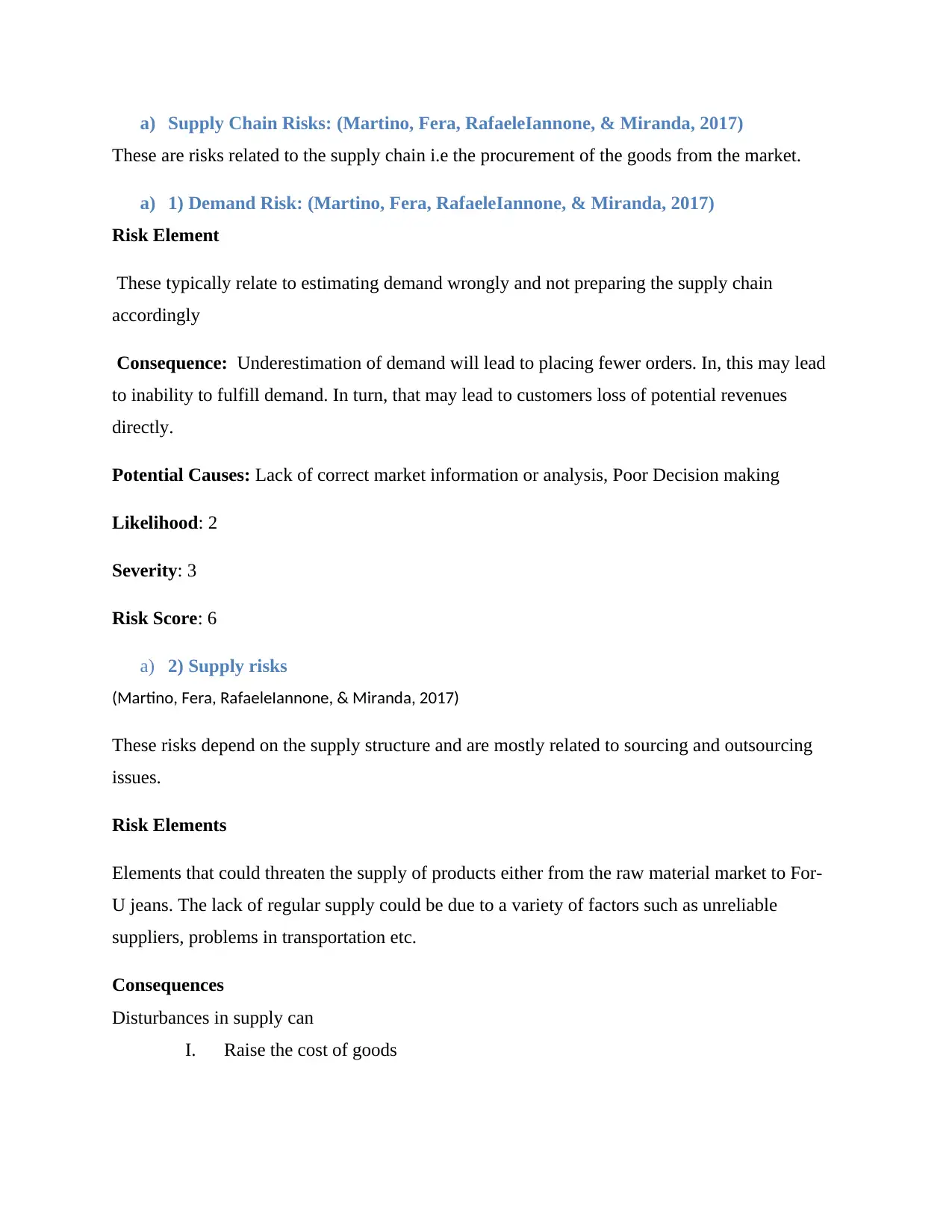
a) Supply Chain Risks: (Martino, Fera, RafaeleIannone, & Miranda, 2017)
These are risks related to the supply chain i.e the procurement of the goods from the market.
a) 1) Demand Risk: (Martino, Fera, RafaeleIannone, & Miranda, 2017)
Risk Element
These typically relate to estimating demand wrongly and not preparing the supply chain
accordingly
Consequence: Underestimation of demand will lead to placing fewer orders. In, this may lead
to inability to fulfill demand. In turn, that may lead to customers loss of potential revenues
directly.
Potential Causes: Lack of correct market information or analysis, Poor Decision making
Likelihood: 2
Severity: 3
Risk Score: 6
a) 2) Supply risks
(Martino, Fera, RafaeleIannone, & Miranda, 2017)
These risks depend on the supply structure and are mostly related to sourcing and outsourcing
issues.
Risk Elements
Elements that could threaten the supply of products either from the raw material market to For-
U jeans. The lack of regular supply could be due to a variety of factors such as unreliable
suppliers, problems in transportation etc.
Consequences
Disturbances in supply can
I. Raise the cost of goods
These are risks related to the supply chain i.e the procurement of the goods from the market.
a) 1) Demand Risk: (Martino, Fera, RafaeleIannone, & Miranda, 2017)
Risk Element
These typically relate to estimating demand wrongly and not preparing the supply chain
accordingly
Consequence: Underestimation of demand will lead to placing fewer orders. In, this may lead
to inability to fulfill demand. In turn, that may lead to customers loss of potential revenues
directly.
Potential Causes: Lack of correct market information or analysis, Poor Decision making
Likelihood: 2
Severity: 3
Risk Score: 6
a) 2) Supply risks
(Martino, Fera, RafaeleIannone, & Miranda, 2017)
These risks depend on the supply structure and are mostly related to sourcing and outsourcing
issues.
Risk Elements
Elements that could threaten the supply of products either from the raw material market to For-
U jeans. The lack of regular supply could be due to a variety of factors such as unreliable
suppliers, problems in transportation etc.
Consequences
Disturbances in supply can
I. Raise the cost of goods
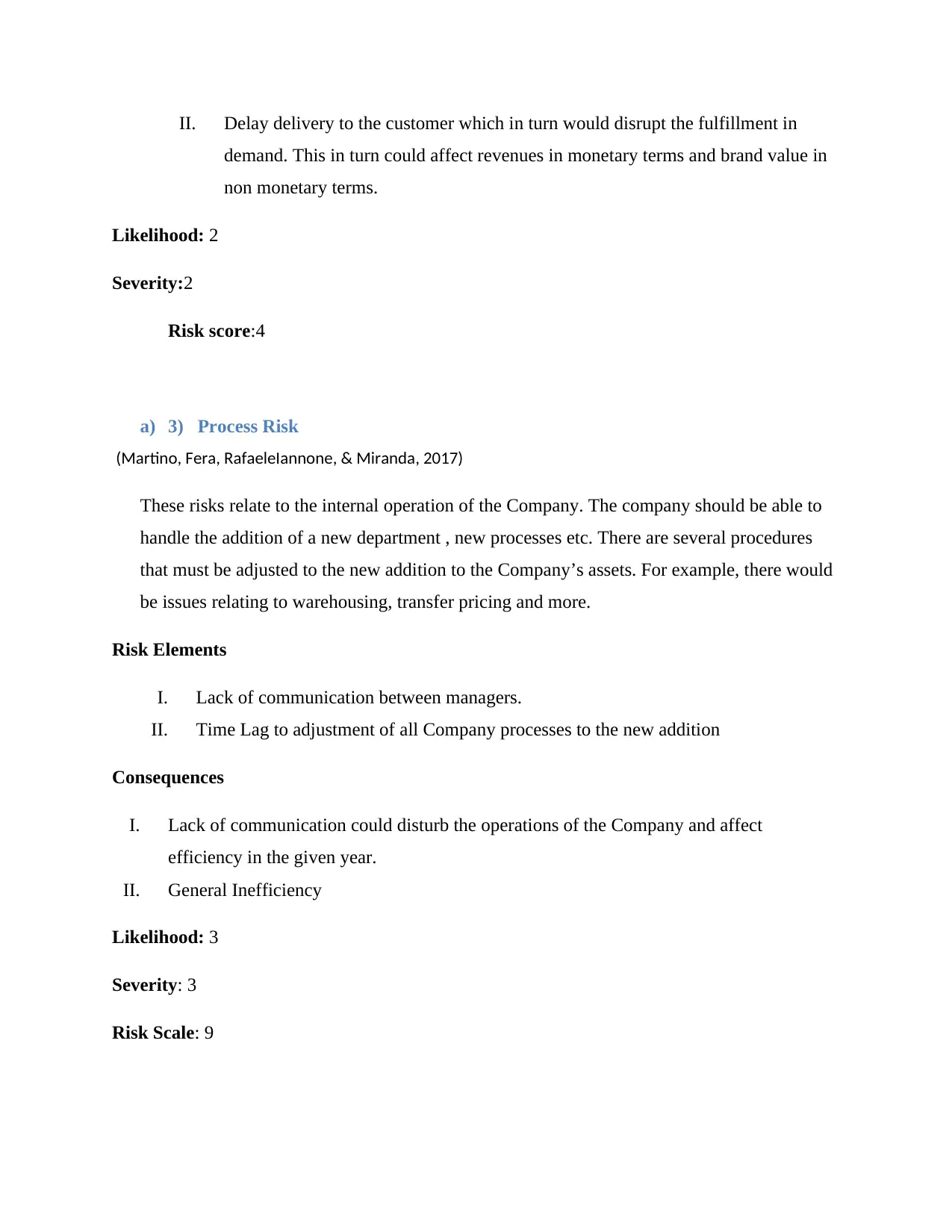
II. Delay delivery to the customer which in turn would disrupt the fulfillment in
demand. This in turn could affect revenues in monetary terms and brand value in
non monetary terms.
Likelihood: 2
Severity:2
Risk score:4
a) 3) Process Risk
(Martino, Fera, RafaeleIannone, & Miranda, 2017)
These risks relate to the internal operation of the Company. The company should be able to
handle the addition of a new department , new processes etc. There are several procedures
that must be adjusted to the new addition to the Company’s assets. For example, there would
be issues relating to warehousing, transfer pricing and more.
Risk Elements
I. Lack of communication between managers.
II. Time Lag to adjustment of all Company processes to the new addition
Consequences
I. Lack of communication could disturb the operations of the Company and affect
efficiency in the given year.
II. General Inefficiency
Likelihood: 3
Severity: 3
Risk Scale: 9
demand. This in turn could affect revenues in monetary terms and brand value in
non monetary terms.
Likelihood: 2
Severity:2
Risk score:4
a) 3) Process Risk
(Martino, Fera, RafaeleIannone, & Miranda, 2017)
These risks relate to the internal operation of the Company. The company should be able to
handle the addition of a new department , new processes etc. There are several procedures
that must be adjusted to the new addition to the Company’s assets. For example, there would
be issues relating to warehousing, transfer pricing and more.
Risk Elements
I. Lack of communication between managers.
II. Time Lag to adjustment of all Company processes to the new addition
Consequences
I. Lack of communication could disturb the operations of the Company and affect
efficiency in the given year.
II. General Inefficiency
Likelihood: 3
Severity: 3
Risk Scale: 9
⊘ This is a preview!⊘
Do you want full access?
Subscribe today to unlock all pages.

Trusted by 1+ million students worldwide
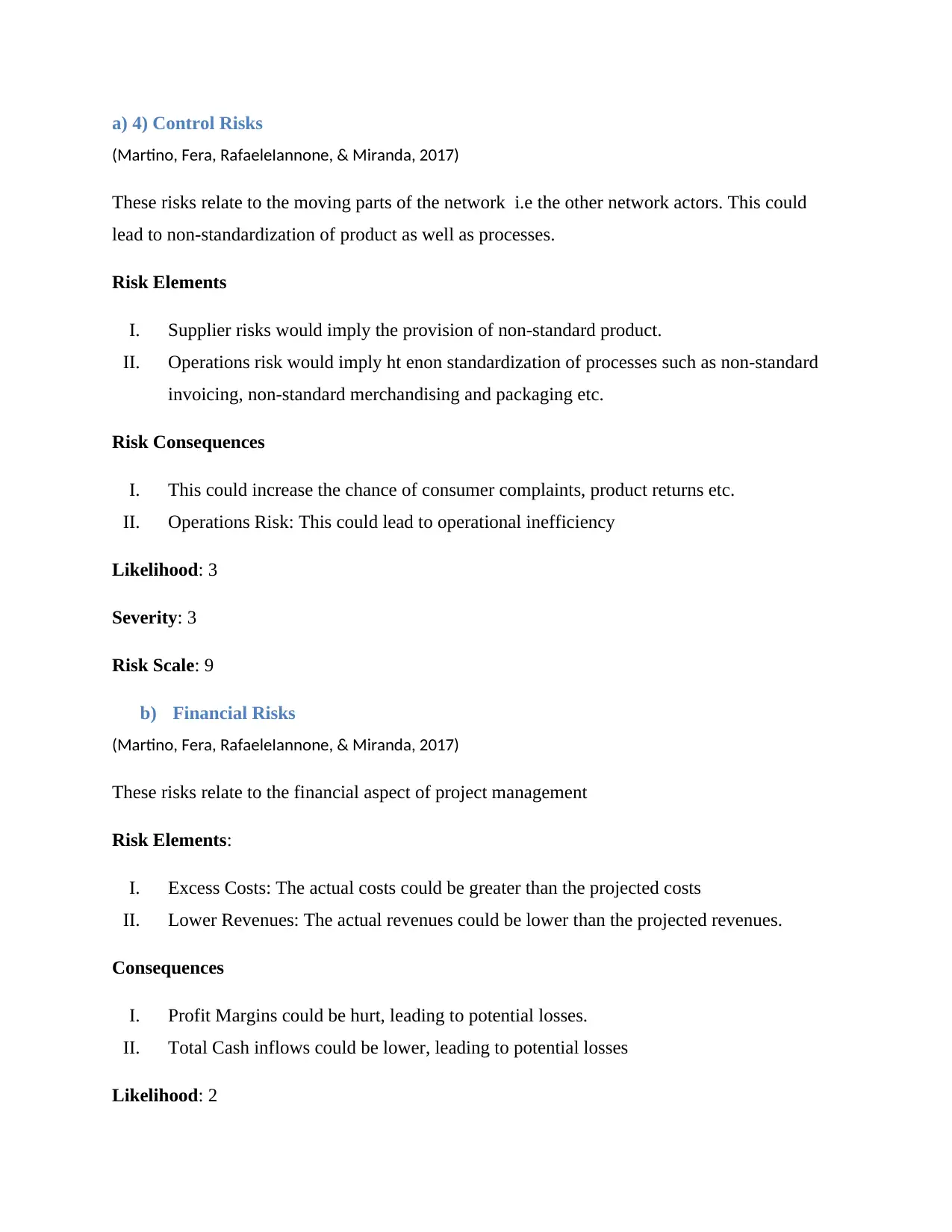
a) 4) Control Risks
(Martino, Fera, RafaeleIannone, & Miranda, 2017)
These risks relate to the moving parts of the network i.e the other network actors. This could
lead to non-standardization of product as well as processes.
Risk Elements
I. Supplier risks would imply the provision of non-standard product.
II. Operations risk would imply ht enon standardization of processes such as non-standard
invoicing, non-standard merchandising and packaging etc.
Risk Consequences
I. This could increase the chance of consumer complaints, product returns etc.
II. Operations Risk: This could lead to operational inefficiency
Likelihood: 3
Severity: 3
Risk Scale: 9
b) Financial Risks
(Martino, Fera, RafaeleIannone, & Miranda, 2017)
These risks relate to the financial aspect of project management
Risk Elements:
I. Excess Costs: The actual costs could be greater than the projected costs
II. Lower Revenues: The actual revenues could be lower than the projected revenues.
Consequences
I. Profit Margins could be hurt, leading to potential losses.
II. Total Cash inflows could be lower, leading to potential losses
Likelihood: 2
(Martino, Fera, RafaeleIannone, & Miranda, 2017)
These risks relate to the moving parts of the network i.e the other network actors. This could
lead to non-standardization of product as well as processes.
Risk Elements
I. Supplier risks would imply the provision of non-standard product.
II. Operations risk would imply ht enon standardization of processes such as non-standard
invoicing, non-standard merchandising and packaging etc.
Risk Consequences
I. This could increase the chance of consumer complaints, product returns etc.
II. Operations Risk: This could lead to operational inefficiency
Likelihood: 3
Severity: 3
Risk Scale: 9
b) Financial Risks
(Martino, Fera, RafaeleIannone, & Miranda, 2017)
These risks relate to the financial aspect of project management
Risk Elements:
I. Excess Costs: The actual costs could be greater than the projected costs
II. Lower Revenues: The actual revenues could be lower than the projected revenues.
Consequences
I. Profit Margins could be hurt, leading to potential losses.
II. Total Cash inflows could be lower, leading to potential losses
Likelihood: 2
Paraphrase This Document
Need a fresh take? Get an instant paraphrase of this document with our AI Paraphraser
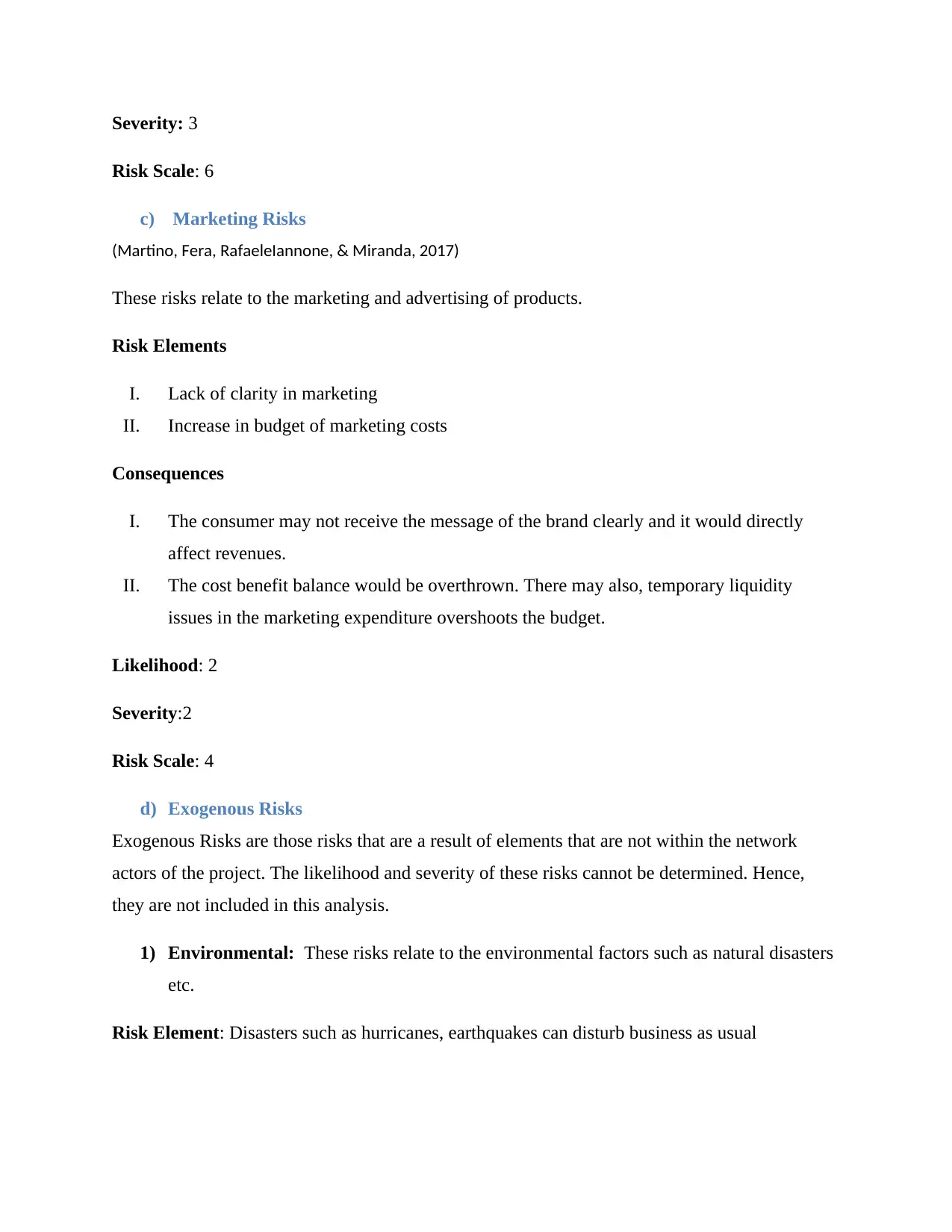
Severity: 3
Risk Scale: 6
c) Marketing Risks
(Martino, Fera, RafaeleIannone, & Miranda, 2017)
These risks relate to the marketing and advertising of products.
Risk Elements
I. Lack of clarity in marketing
II. Increase in budget of marketing costs
Consequences
I. The consumer may not receive the message of the brand clearly and it would directly
affect revenues.
II. The cost benefit balance would be overthrown. There may also, temporary liquidity
issues in the marketing expenditure overshoots the budget.
Likelihood: 2
Severity:2
Risk Scale: 4
d) Exogenous Risks
Exogenous Risks are those risks that are a result of elements that are not within the network
actors of the project. The likelihood and severity of these risks cannot be determined. Hence,
they are not included in this analysis.
1) Environmental: These risks relate to the environmental factors such as natural disasters
etc.
Risk Element: Disasters such as hurricanes, earthquakes can disturb business as usual
Risk Scale: 6
c) Marketing Risks
(Martino, Fera, RafaeleIannone, & Miranda, 2017)
These risks relate to the marketing and advertising of products.
Risk Elements
I. Lack of clarity in marketing
II. Increase in budget of marketing costs
Consequences
I. The consumer may not receive the message of the brand clearly and it would directly
affect revenues.
II. The cost benefit balance would be overthrown. There may also, temporary liquidity
issues in the marketing expenditure overshoots the budget.
Likelihood: 2
Severity:2
Risk Scale: 4
d) Exogenous Risks
Exogenous Risks are those risks that are a result of elements that are not within the network
actors of the project. The likelihood and severity of these risks cannot be determined. Hence,
they are not included in this analysis.
1) Environmental: These risks relate to the environmental factors such as natural disasters
etc.
Risk Element: Disasters such as hurricanes, earthquakes can disturb business as usual
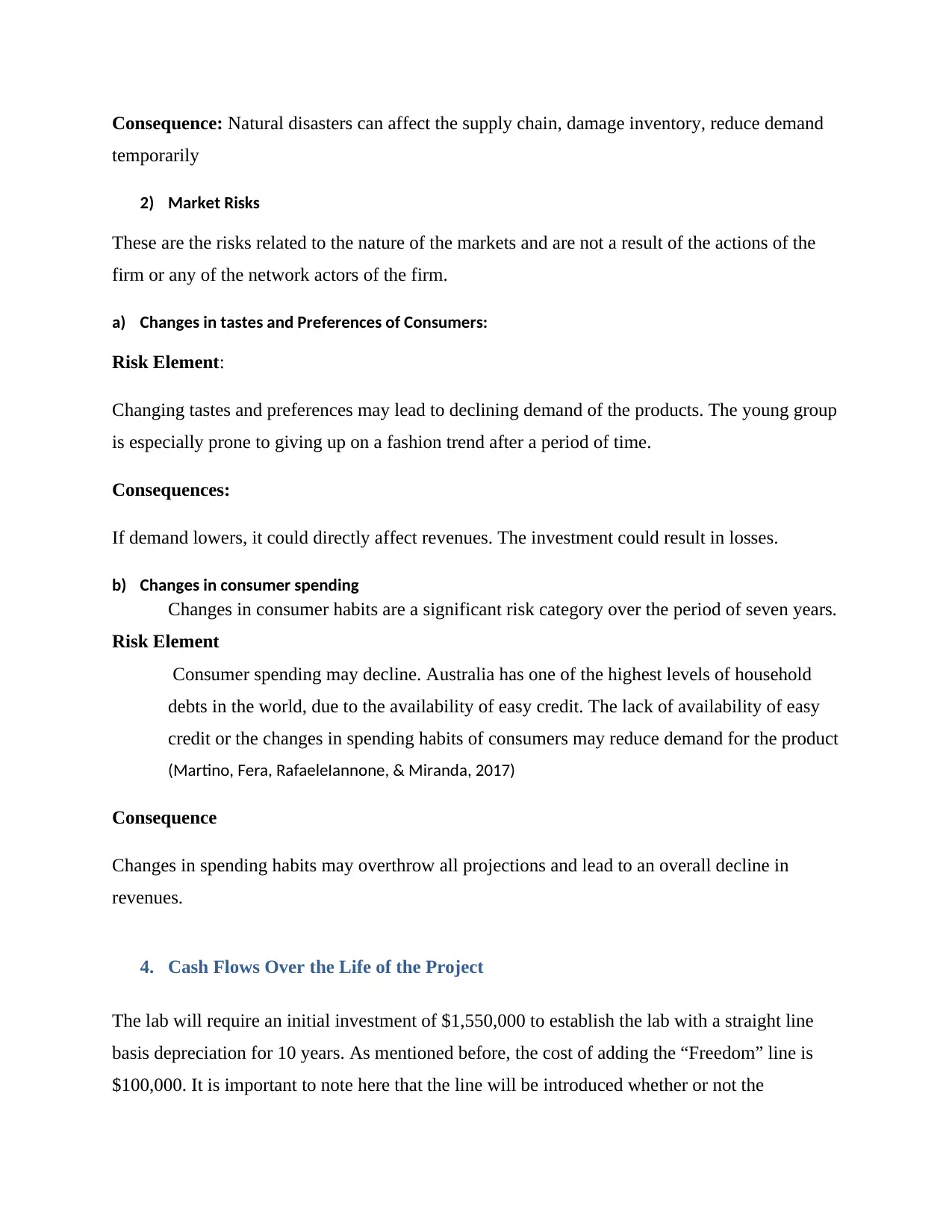
Consequence: Natural disasters can affect the supply chain, damage inventory, reduce demand
temporarily
2) Market Risks
These are the risks related to the nature of the markets and are not a result of the actions of the
firm or any of the network actors of the firm.
a) Changes in tastes and Preferences of Consumers:
Risk Element:
Changing tastes and preferences may lead to declining demand of the products. The young group
is especially prone to giving up on a fashion trend after a period of time.
Consequences:
If demand lowers, it could directly affect revenues. The investment could result in losses.
b) Changes in consumer spending
Changes in consumer habits are a significant risk category over the period of seven years.
Risk Element
Consumer spending may decline. Australia has one of the highest levels of household
debts in the world, due to the availability of easy credit. The lack of availability of easy
credit or the changes in spending habits of consumers may reduce demand for the product
(Martino, Fera, RafaeleIannone, & Miranda, 2017)
Consequence
Changes in spending habits may overthrow all projections and lead to an overall decline in
revenues.
4. Cash Flows Over the Life of the Project
The lab will require an initial investment of $1,550,000 to establish the lab with a straight line
basis depreciation for 10 years. As mentioned before, the cost of adding the “Freedom” line is
$100,000. It is important to note here that the line will be introduced whether or not the
temporarily
2) Market Risks
These are the risks related to the nature of the markets and are not a result of the actions of the
firm or any of the network actors of the firm.
a) Changes in tastes and Preferences of Consumers:
Risk Element:
Changing tastes and preferences may lead to declining demand of the products. The young group
is especially prone to giving up on a fashion trend after a period of time.
Consequences:
If demand lowers, it could directly affect revenues. The investment could result in losses.
b) Changes in consumer spending
Changes in consumer habits are a significant risk category over the period of seven years.
Risk Element
Consumer spending may decline. Australia has one of the highest levels of household
debts in the world, due to the availability of easy credit. The lack of availability of easy
credit or the changes in spending habits of consumers may reduce demand for the product
(Martino, Fera, RafaeleIannone, & Miranda, 2017)
Consequence
Changes in spending habits may overthrow all projections and lead to an overall decline in
revenues.
4. Cash Flows Over the Life of the Project
The lab will require an initial investment of $1,550,000 to establish the lab with a straight line
basis depreciation for 10 years. As mentioned before, the cost of adding the “Freedom” line is
$100,000. It is important to note here that the line will be introduced whether or not the
⊘ This is a preview!⊘
Do you want full access?
Subscribe today to unlock all pages.

Trusted by 1+ million students worldwide
1 out of 24
Related Documents
Your All-in-One AI-Powered Toolkit for Academic Success.
+13062052269
info@desklib.com
Available 24*7 on WhatsApp / Email
![[object Object]](/_next/static/media/star-bottom.7253800d.svg)
Unlock your academic potential
Copyright © 2020–2025 A2Z Services. All Rights Reserved. Developed and managed by ZUCOL.





